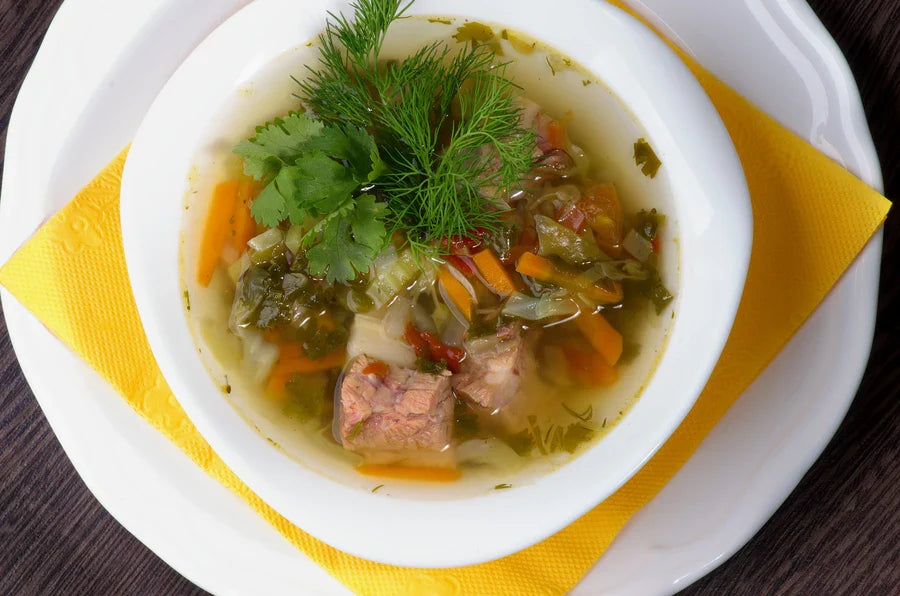
Thawing Frozen Soup: How to Defrost It Quickly and Safely
Teilen
Nothing beats the satisfaction of opening your freezer on a hectic Tuesday evening and finding containers of homemade soup waiting to rescue dinner. Frozen soup represents one of the smartest meal prep strategies – nutritious, comforting meals that can be prepared when you have time and enjoyed when you don't. But there's often a gap between frozen soup and steaming bowl, and how you bridge that gap can make the difference between a perfect meal and a disappointing one.
The challenge isn't just getting frozen soup from solid to liquid – it's doing so while preserving the flavors, textures, and nutritional value that made you freeze it in the first place. Some thawing methods work better for certain types of soup, while others prioritize speed over quality or safety over convenience.
Understanding the best approaches for different situations means you'll always have a reliable plan for turning those frozen blocks into satisfying meals, whether you remembered to plan ahead or need soup on the table in the next hour.

Understanding Frozen Soup and Its Benefits
Freezing soup works so well because most soup components handle the freezing and thawing process gracefully. The high water content in soups means they freeze relatively quickly and completely, while the cooking process has already broken down many cellular structures that might be damaged by ice crystal formation.
Different types of soups freeze with varying degrees of success:
- Excellent freezers – Broth-based soups, vegetable soups, meat stews, bean and lentil soups
- Good with care – Creamy soups (may separate slightly but restore with gentle reheating)
- Texture changes – Soups with pasta or potatoes (softer but still flavorful)
- Nutritional retention – Vitamins and minerals remain largely intact through freezing
Proper freezing techniques contribute significantly to successful thawing results. Soups frozen in shallow containers thaw more quickly and evenly than those in deep containers. Leaving appropriate headspace prevents container damage from expansion, while proper labeling ensures you know what you're thawing and how long it's been frozen.
How to Defrost Frozen Soup Safely
Safe thawing practices prevent bacterial growth while maintaining soup quality, making food safety a priority in any thawing method you choose.
Defrosting Soup in the Refrigerator: The Slow Thaw Method
Refrigerator thawing represents the safest method for thawing frozen soup, though it requires the most planning time. This method maintains safe temperatures throughout the thawing process, preventing any portion of the soup from entering the temperature danger zone where bacteria can multiply.
Move frozen soup containers from the freezer to the refrigerator 24-48 hours before you plan to serve them, depending on the container size and soup volume. Large containers or thick soups may require the full 48 hours, while smaller portions might thaw completely in 12-24 hours.
The slow thawing process allows ice crystals to melt gradually, which helps maintain the soup's original texture better than rapid thawing methods. This is particularly important for soups with delicate ingredients or complex textures that might be damaged by quick temperature changes.
Place thawing containers on plates or trays to catch any condensation that forms during the thawing process. This prevents moisture from dripping onto other foods and makes cleanup easier. Keep the soup covered during thawing to prevent it from absorbing odors from other foods in the refrigerator.
Defrosting Soup Using Cold Water: A Faster Option
Cold water thawing offers a middle ground between safety and speed, providing faster results than refrigerator thawing while maintaining food safety standards. This method works particularly well when you need soup within a few hours but didn't plan far enough ahead for refrigerator thawing.
Submerge the sealed soup container in cold water, ensuring the container is watertight to prevent contamination. Change the water every 30 minutes to maintain cold temperatures and promote even thawing. Most soup containers will thaw completely within 2-4 hours using this method, depending on size and thickness.
The key to successful cold water thawing is maintaining water temperature below 70°F and changing it regularly. Stagnant water warms up and can allow bacterial growth, while fresh cold water continues to draw heat from the frozen soup safely and efficiently.
For faster results, you can break up the frozen soup gently as it begins to thaw, being careful not to damage the container. This increases the surface area exposed to the cold water and speeds up the thawing process while maintaining safe temperatures throughout.
How to Defrost Frozen Soup Quickly
When time is short, faster thawing methods can get soup from frozen to table-ready in under an hour, though these methods require more attention and careful handling.
Defrosting Soup on the Stove (in a Pot)
Stovetop thawing offers excellent control over the process and works well for most types of soup when done properly. This method allows you to monitor the soup closely and adjust heat as needed to prevent scorching while ensuring even heating throughout.
Remove frozen soup from its container and place it in a heavy-bottomed pot over low heat. If the soup won't release from the container easily, run warm water over the outside of the container briefly to loosen it. Add a small amount of water or broth to the bottom of the pot to prevent sticking as the soup begins to melt.
Heat the soup slowly, stirring gently as it thaws to promote even heating and prevent hot spots that might scorch the soup. Increase heat gradually as more of the soup becomes liquid, but avoid high heat that might cause rapid boiling or scorching before the soup is completely thawed.
Essential tips for stovetop thawing:
- Use low heat initially – Prevents scorching and promotes even thawing
- Stir gently and frequently – Breaks up ice chunks and distributes heat
- Add liquid if needed – Prevents sticking and aids in even heating
- Monitor closely – Allows for heat adjustments as the soup thaws
The stovetop method works particularly well for hearty soups and stews that benefit from gentle reheating. It also allows you to taste and adjust seasonings as the soup heats, since freezing can sometimes dull flavors slightly.
Defrosting Soup in the Microwave
Microwave thawing provides the fastest results but requires careful technique to prevent uneven heating and maintain soup quality. Modern microwaves with defrost settings make this process more manageable, but any microwave can be used successfully with proper technique.
Transfer frozen soup to a microwave-safe container, breaking it into smaller pieces if possible to promote even heating. Use the microwave's defrost setting if available, or set the power to 30-50% for gentler thawing. This prevents the edges from cooking while the center remains frozen.
Microwave the soup in short intervals, typically 2-3 minutes at a time, stirring between each interval to redistribute heat and break up any remaining ice chunks. This interval approach prevents overheating and ensures more even results than continuous microwaving.
Cover the soup loosely during microwaving to retain moisture while allowing steam to escape. Tight covers can cause pressure buildup, while no cover at all can lead to splattering and moisture loss that affects the soup's final consistency.
Be particularly careful with cream-based soups in the microwave, as dairy products can curdle if heated too quickly. Use shorter intervals and lower power settings for these soups, and stir more frequently to prevent separation.
Tips for Maintaining Quality During Thawing
Several factors influence the final quality of thawed soup, and understanding these can help you achieve better results regardless of which thawing method you choose.
- Temperature control throughout the thawing process affects both safety and quality. Avoid temperature extremes that might shock the soup or create uneven heating patterns. Gradual temperature changes produce better texture and flavor retention than rapid changes.
- Stirring technique matters more than many people realize. Gentle stirring helps distribute heat evenly and prevents hot spots, while aggressive stirring can break down delicate ingredients or create a muddy texture in soups with distinct components.
- Seasoning adjustments may be necessary after thawing, as freezing can sometimes dull flavors. Taste the soup after it's fully heated and add salt, herbs, or acid as needed to restore the original flavor profile. Fresh herbs added after thawing often provide brighter flavors than frozen herbs.
- Container choice for reheating can affect results significantly. Heavy-bottomed pots distribute heat more evenly than thin pots, while microwave-safe containers with wide surfaces heat more evenly than deep, narrow containers.
Common Mistakes to Avoid
Understanding common thawing mistakes helps prevent disappointing results and food safety issues that can occur when proper techniques aren't followed.
Common thawing errors to avoid:
- Using hot water – Creates food safety risks and uneven heating
- Room temperature thawing – Allows dangerous bacterial growth
- Refreezing thawed soup – Compromises safety and quality significantly
- Rushing the reheating – Often leads to scorched soup or uneven heating
- Ignoring food safety timing – Thawed soup should be consumed within 2-3 days
Using hot water for quick thawing might seem logical, but it can create food safety risks by allowing portions of the soup to reach unsafe temperatures while other parts remain frozen. Hot water can also create uneven heating that affects texture and may partially cook some ingredients while others remain cold.

Taking time to heat soup properly ensures better flavor and texture while preventing burning that can ruin an entire batch. The texture and flavor deteriorate with each freeze-thaw cycle, and food safety risks increase with improper handling.
Making Frozen Soup Work for You
Successfully thawing frozen soup depends on choosing the right method for your time constraints and soup type while following proper food safety practices. Planning ahead allows for the safest, highest-quality results, but quick methods can produce excellent soup when time is limited.
The key to success lies in understanding how different soups respond to various thawing methods and adjusting your approach accordingly. Cream soups need gentler handling than broth-based soups, while chunky stews can handle more aggressive thawing than delicate bisques.
Proper planning makes the biggest difference in results. Knowing when you'll want soup and choosing your thawing method accordingly ensures the best possible outcome. Even quick thawing methods produce better results when you're not rushing through them under extreme time pressure.
With these techniques mastered, frozen soup becomes a reliable solution for nutritious, satisfying meals that require minimal time and effort to prepare. The convenience of having homemade soup available at any time makes the initial investment in preparation and proper freezing techniques worthwhile for busy households that value both convenience and quality in their meals.

